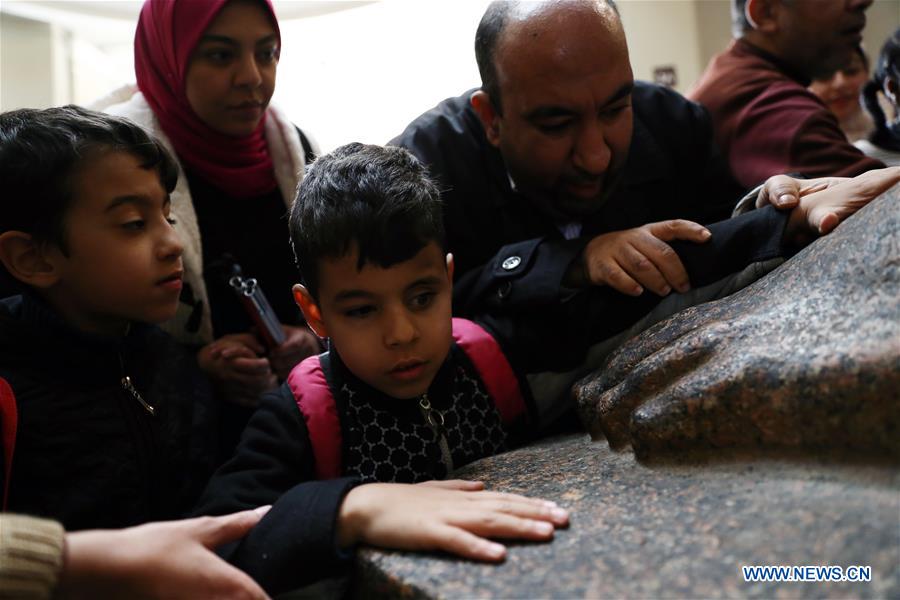
Visually impaired children touch a statue in Egyptian Museum in Cairo, Egypt, Jan. 13, 2020. (Xinhua/Ahmed Gomaa)
by Mahmoud Fouly
CAIRO, Jan. 16 (Xinhua) -- At the main hall of the Egyptian Museum near Tahrir Square in downtown Cairo, a group of blind children were touching the feet and legs of a massive granite statue of ancient Egyptian King Ramses II, while accompanied by their sightless tour guide.
They looked as if they were seeing the antiquities with their hands, using their imagination instead of their vision. They were assisted by Braille tags for each monument on their special path.
The tour was part of the activities of the museum's school for raising blind children's archeological awareness.
"It's not an actual school with a building, but it's an activity of the Ministry of Tourism and Antiquities to raise visually impaired children's awareness of their heritage and monuments through their tour in the museum," said Adel Fouad, a visually impaired tour guide and a researcher at the ministry.
"Regular schools for blind kids tell them about Egypt's ancient history, but our symbolic school let them practically touch different archeological pieces and communicate with their own history," Fouad, the chief supervisor of the museum's school, told Xinhua.
Fouad and his fellow blind tour guides deal with all ages of blind visitors of the museum starting from the age of six. They follow psychological rules and consider the different mentalities of visually impaired visitors while guiding them during the tours.
The Children's Museum of Lego inside the Egyptian Museum was part of the tour, where the unsighted children would touch copies of Pharaohs and the Sphinx made of thousands of little Lego pieces.
Adam, a little boy who came with a group from a foundation for visually impaired children, seemed very excited during the tour, especially that he and his peers touched the features of a Lego-made copy of the golden mask of King Tutankhamun.
"I was very happy to play with the Lego pieces and touch the statues and all these nice things. I also touched the feet of a statue out there and they were too big. I would love to come here again," said the six-year-old child, who is in his first year of elementary school.
The museum's blind visitors have a special itinerary, including 12 masterpieces of Egyptian antiquities with a Braille map to guide them. Among the 12 pieces are the Narmer Palette, a statue of King Ramses II, the sphinx of King Amenemhat III, a mummification table, coffins, and others.
"The path for the visually impaired was gifted to the Egyptian Museum in mid-2019 by an Italian museum that also provided Braille labels in Arabic, English and Italian for the pieces of the itinerary," said Ahmed Naguib, a tour guide for visually impaired people.
He explained that visually impaired visitors cannot see all the antiquities featured in the museum because most of them are placed inside showcases, but they can only touch those uncovered pieces made of granite or basalt.
"As for the antiquities made of sandstone or limestone, they can only touch their copies," said the visually impaired tour guide, who is also deputy supervisor of the museum's school for blind visitors.
Another group of blind children gathered around a large coffin in the museum's main hall, while Naguib gave them basic information about how ancient Egyptians kept mummies inside coffins. Some also approached a basalt statue of an ancient king, imagining his face via the tips of their fingers.
"We made an experiment during an exhibition inside the museum in 2016 called 'You Can See with Your Hands,' and the minister of antiquities himself closed his eyes and touched the special copies of antiquities made for the visually impaired," the tour guide told Xinhua.
The Egyptian Museum's school for raising archeological awareness of blind visitors cooperates with special schools and non-government organizations to arrange visits for the visually impaired to the museum.
The school also started a new initiative based on "mobility," through which the tour guides visit visually impaired children at their schools with copies of the museum's famous antiquities as if it's "a mobile museum."
Amal Ezzat, head of Hope City Foundation for handicapped children, said she was happy with the tour arranged with the museum's school to teach her visually impaired students about their country's history and heritage.
"We release our visually impaired kids from the prison of disability to explore life. We take them to museums and teach them what museums are and what they contain. They are not quick learners but with patience and persistence we integrate them into the society," the foundation's chief told Xinhua.